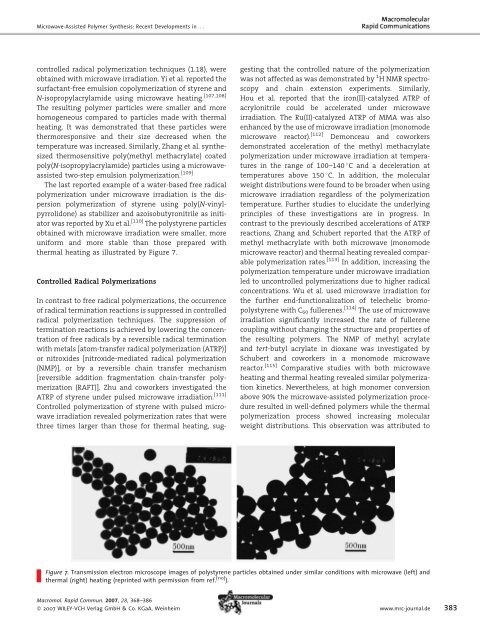Microwave-Assisted Polymer Synthesis: Recent Developments in a ...
Microwave-Assisted Polymer Synthesis: Recent Developments in a ...
Microwave-Assisted Polymer Synthesis: Recent Developments in a ...
Create successful ePaper yourself
Turn your PDF publications into a flip-book with our unique Google optimized e-Paper software.
<strong>Microwave</strong>-<strong>Assisted</strong> <strong>Polymer</strong> <strong>Synthesis</strong>: <strong>Recent</strong> <strong>Developments</strong> <strong>in</strong> ...<br />
controlled radical polymerization techniques (1.18), were<br />
obta<strong>in</strong>ed with microwave irradiation. Yi et al. reported the<br />
surfactant-free emulsion copolymerization of styrene and<br />
N-isopropylacrylamide us<strong>in</strong>g microwave heat<strong>in</strong>g. [107,108]<br />
The result<strong>in</strong>g polymer particles were smaller and more<br />
homogeneous compared to particles made with thermal<br />
heat<strong>in</strong>g. It was demonstrated that these particles were<br />
thermoresponsive and their size decreased when the<br />
temperature was <strong>in</strong>creased. Similarly, Zhang et al. synthesized<br />
thermosensitive poly(methyl methacrylate) coated<br />
poly(N-isopropylacrylamide) particles us<strong>in</strong>g a microwaveassisted<br />
two-step emulsion polymerization. [109]<br />
The last reported example of a water-based free radical<br />
polymerization under microwave irradiation is the dispersion<br />
polymerization of styrene us<strong>in</strong>g poly(N-v<strong>in</strong>ylpyrrolidone)<br />
as stabilizer and azoisobutyronitrile as <strong>in</strong>itiator<br />
was reported by Xu et al. [110] The polystyrene particles<br />
obta<strong>in</strong>ed with microwave irradiation were smaller, more<br />
uniform and more stable than those prepared with<br />
thermal heat<strong>in</strong>g as illustrated by Figure 7.<br />
Controlled Radical <strong>Polymer</strong>izations<br />
In contrast to free radical polymerizations, the occurrence<br />
of radical term<strong>in</strong>ation reactions is suppressed <strong>in</strong> controlled<br />
radical polymerization techniques. The suppression of<br />
term<strong>in</strong>ation reactions is achieved by lower<strong>in</strong>g the concentration<br />
of free radicals by a reversible radical term<strong>in</strong>ation<br />
with metals [atom-transfer radical polymerization (ATRP)]<br />
or nitroxides [nitroxide-mediated radical polymerization<br />
(NMP)], or by a reversible cha<strong>in</strong> transfer mechanism<br />
[reversible addition fragmentation cha<strong>in</strong>-transfer polymerization<br />
(RAFT)]. Zhu and coworkers <strong>in</strong>vestigated the<br />
ATRP of styrene under pulsed microwave irradiation. [111]<br />
Controlled polymerization of styrene with pulsed microwave<br />
irradiation revealed polymerization rates that were<br />
three times larger than those for thermal heat<strong>in</strong>g, suggest<strong>in</strong>g<br />
that the controlled nature of the polymerization<br />
was not affected as was demonstrated by 1 H NMR spectroscopy<br />
and cha<strong>in</strong> extension experiments. Similarly,<br />
Hou et al. reported that the iron(II)-catalyzed ATRP of<br />
acrylonitrile could be accelerated under microwave<br />
irradiation. The Ru(II)-catalyzed ATRP of MMA was also<br />
enhanced by the use of microwave irradiation (monomode<br />
microwave reactor). [112] Demonceau and coworkers<br />
demonstrated acceleration of the methyl methacrylate<br />
polymerization under microwave irradiation at temperatures<br />
<strong>in</strong> the range of 100–140 8C and a deceleration at<br />
temperatures above 150 8C. In addition, the molecular<br />
weight distributions were found to be broader when us<strong>in</strong>g<br />
microwave irradiation regardless of the polymerization<br />
temperature. Further studies to elucidate the underly<strong>in</strong>g<br />
pr<strong>in</strong>ciples of these <strong>in</strong>vestigations are <strong>in</strong> progress. In<br />
contrast to the previously described accelerations of ATRP<br />
reactions, Zhang and Schubert reported that the ATRP of<br />
methyl methacrylate with both microwave (monomode<br />
microwave reactor) and thermal heat<strong>in</strong>g revealed comparable<br />
polymerization rates. [113] In addition, <strong>in</strong>creas<strong>in</strong>g the<br />
polymerization temperature under microwave irradiation<br />
led to uncontrolled polymerizations due to higher radical<br />
concentrations. Wu et al. used microwave irradiation for<br />
the further end-functionalization of telechelic bromopolystyrene<br />
with C 60 fullerenes. [114] The use of microwave<br />
irradiation significantly <strong>in</strong>creased the rate of fullerene<br />
coupl<strong>in</strong>g without chang<strong>in</strong>g the structure and properties of<br />
the result<strong>in</strong>g polymers. The NMP of methyl acrylate<br />
and tert-butyl acrylate <strong>in</strong> dioxane was <strong>in</strong>vestigated by<br />
Schubert and coworkers <strong>in</strong> a monomode microwave<br />
reactor. [115] Comparative studies with both microwave<br />
heat<strong>in</strong>g and thermal heat<strong>in</strong>g revealed similar polymerization<br />
k<strong>in</strong>etics. Nevertheless, at high monomer conversion<br />
above 90% the microwave-assisted polymerization procedure<br />
resulted <strong>in</strong> well-def<strong>in</strong>ed polymers while the thermal<br />
polymerization process showed <strong>in</strong>creas<strong>in</strong>g molecular<br />
weight distributions. This observation was attributed to<br />
Figure 7. Transmission electron microscope images of polystyrene particles obta<strong>in</strong>ed under similar conditions with microwave (left) and<br />
thermal (right) heat<strong>in</strong>g (repr<strong>in</strong>ted with permission from ref. [110] ).<br />
Macromol. Rapid Commun. 2007, 28, 368–386<br />
ß 2007 WILEY-VCH Verlag GmbH & Co. KGaA, We<strong>in</strong>heim www.mrc-journal.de 383
















